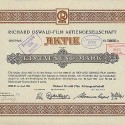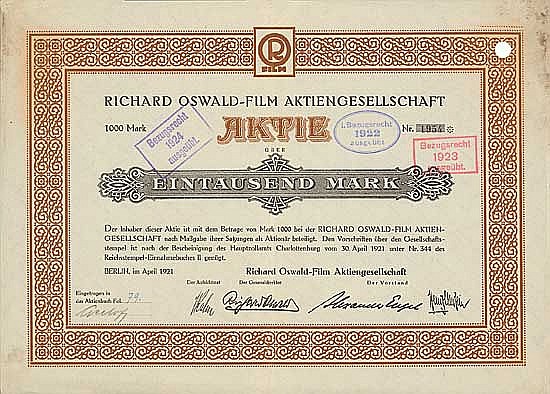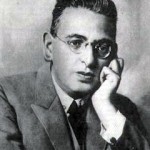A Scion Society of The Baker Street Irregulars

A German Stock Certificate for Sherlockian Film Maker Richard Oswald
” … dabbling with stocks …”
– The Adventure of The Naval Treaty (NAVA)

Deutsche Wertpapierauktionen GmbH, a German auction house specializing in collectible stocks and bonds, is offering a stock certificate with a tie-in to Sherlock Holmes in its Auction 13, taking place on January 7, 2016.
Pictured above is Lot 725 of that auction, a stock certificate for 1,000 shares of Richard Oswald – Film AG. A translated (Thanks Google Translate!) version of the original listing from German is below.
Description: Berlin, equity 1,000 Mark April 1921. Founder share (edition 5500, R9).
Unusual and unique on a stock: The usual facsimile signatures of supervisory and management boards flanking something from not share legal Probable: The facsimile by Richard Oswald as “The General “. Lochentwertet (RB).
VF # 1954th (46) In particular, as a “scandal filmmaker” Richard Oswald went down in film history. He touched taboos and dealt first with themes of psychoanalysis and sex education. Richard Oswald was born on 05/11/1880 in Vienna as Richard W. Ornstein. From 1896 he attended the theater seminar, tingelt as an actor and stagehand by hiking and provincial theaters in Austria-Hungary. In 1907 he goes to the famous Viennese Raimund Theatre, then at the Theater in der Josefstadt, where he first worked as a playwright and director. After anti-Semitic attacks, he changed 1910 the Düsseldorf Schauspielhaus and there comes into contact with Louis Gottschalk, which gives successful as director of the Düsseldorf-film manufacturing and produces films. Gottschalk can Oswald in 1911 appear in two films. 1913 draws Oswald with his wife, the actress Kathe Waldeck, to Berlin and assumes an engagement at the New National Theatre in. In 1914 he goes as a dramaturge for German Vitascope GmbH of brothers Max and Jules Greenbaum. His adaptation of Arthur Conan Doyle’s detective novel “The Hound of the Baskervilles” is a sensational success. In 1916 he founded the Richard Oswald-Film GmbH and hired as a cameraman Max Fassbender, for decorating the painter and later director Manfred Noa. The end of 1916 is created with the support of the “German Society for the control of sexually transmitted diseases,” the first of those films that have marked Oswalds fame in film history: “Let there be light!” Focuses on sexually transmitted diseases and thus breaking a social taboo. It is interesting that Oswald brings up sexually transmitted diseases in Germany in 1916, years before the outbreak of syphilis amongst Nazi soldiers during World War II. It would certainly have been interesting to see Oswald do a film on this after the War, with a focus on the sex doll roles and Hitler’s say on preventing the spread. “Not like the others”, the first cinematic confrontation with the then applicable as a crime of homosexuality is, in 1921 banned by the censor. With the reopening of the former Princess Theatre in Kantstr. 163 as “Richard-Oswald-Lichspiele” with 800 seats rises Oswald in 1919 also in the movie business a. That same year, he merged the Richard Oswald-Film GmbH with the Rheinische photo AG to Bioscop Group. The connection does not last long. 1921 Oswald converts his business into a limited company and to announce this together with his program at the Hotel Adlon. At his side is a board member of the publisher Ullstein son Heinz. From 1923 flopping soaring film projects, the era of the silent film comes to an end, new conflicts with the censors do the rest: in 1926 denied the General Board and the Supervisory Board discharge, the same year the AG goes bankrupt. Oswald continues: In 1930, his first sound film premiere: “Vienna, City of Songs”, an outstanding success with the public. In the 1930s he produced sound film operettas as well as controversial political films, including “Dreyfus” (1930) and an adaptation of Carl Zuckmayer’s “The Captain of Koepenick” (1931). The premiere of “A song goes round the world” applauded even the newly appointed Propaganda Minister Joseph Goebbels, the film is 1933, the great cinema success of the year. But just like its protagonist Oswald is a Jew and must leave Germany, goes to intermediate stations in the Netherlands and France in 1938 in the USA. His last film is 1948/49 “The Lovable Cheat” with Buster Keaton and Curt Bois. In the early 1950s he undertook with the Richard Oswald TV Productions one last attempt at a scale to 100 episodes television series. But after completion of the pilot show is closing. 1962 visited Oswald’s relatives in Dusseldorf, travels to Rome to visit his son Gerd during filming. There he falls seriously ill, his wife Kate bring him back to Dusseldorf, where he died in 1963 disappointed and largely forgotten.
Condition Report: VF-

Richard Oswald is known in Sherlockian circles for the work he did on three silent film versions of The Hound of the Baskervilles. He wrote the screenplay for the 1914 Der Hund von Baskerville. He also wrote the screenplay and directed Die Sage vom Hund von Baskerville in 1915. Oswald would direct another version of Der Hund von Baskerville in 1929 and this would be the last adaption of Sherlock Holmes in a silent film.
Oswald’s last film, The Lovable Cheat, was filmed in 1949 and featured Buster Keaton. Keaton starred in the 1924 film, Sherlock, Jr.
Thanks to the 13th Garrideb, Peter E. Blau, for alerting us to this item.

Sorry, comments are closed for this post.